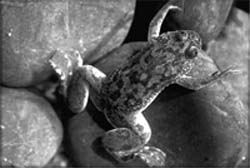Need a hand?
 common sense tells us that limbs of all animals have three clear axes: shoulder-to-tip (proximal-distal), thumb-to-little finger (anterior-posterior), and wrist-to-palm (dorsal-ventral). The arrangement of bones confirms this and reveals a similar pattern in birds as well, whose limbs appear to differ drastically from humans for instance.
common sense tells us that limbs of all animals have three clear axes: shoulder-to-tip (proximal-distal), thumb-to-little finger (anterior-posterior), and wrist-to-palm (dorsal-ventral). The arrangement of bones confirms this and reveals a similar pattern in birds as well, whose limbs appear to differ drastically from humans for instance.
Among the more impressive pieces of synthesis in modern developmental biology is the realisation that limb development depends on similar genes. This, in turn, implies that deep down, the mechanisms of limb development must to be the same in all vertebrates. If true, it means the basic principles of limb development have remained the same right from the beginning of the evolution in vertebrates. A recent report by B Christen and J M W Slack of the University of Bath, uk , contradicts all this and points out that amphibians use a different sort of genetic logic to form limbs ( Nature , Vol 395, No 2134). More specifically, the genetic circuitry responsible for limb development along the dorsal-ventral axis differs between amphibians and mammals.
The current belief regarding limb development is that it depends on a combination of growth and patterning, with the latter depending crucially on special groups of cells, known as signalling centres. These signalling centres release diffusible small molecules that
Related Content
- An eye on methane: international methane emissions observatory 2023 report
- Order of the Calcutta High Court regarding public opposition to a solid waste management plant, Bongaon, North 24 Parganas, West Bengal, 28/08/2023
- Africa’s resource future: harnessing natural resources for economic transformation during the low-carbon transition
- Order of the National Green Tribunal regarding CETP at Roha industrial area, Raigad district, Maharashtra, 31/03/2023
- Air pollution and climate change: from co-benefits to coherent policies
- Report filed by the Ministry of Environment, Forest and Climate Change on Western Ghats eco-sensitive area, 14/10/2022
